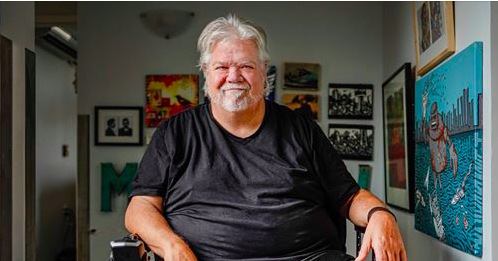NICK KREWEN
Special to the Star
December 20, 2019
Michael Wrycraft is in a conundrum.
As a music aficionado, the Juno Award-winning graphic design artist who has designed album covers for everyone ranging from Bruce Cockburn to Blackie & the Rodeo Kings, loves to attend concerts.
However, Wrycraft lost his legs in 2017 due to diabetes and now uses a wheelchair.
Most of the venues that host the shows he wants to see are not wheelchair-accessible.
If a performance is being held at the Pilot, the Dakota, Grossman’s Tavern, Hugh’s Room Live, Painted Lady or Revival, Wrycraft is unable to attend, thwarted by steep flights of stairs or lack of access ramps.
“I find it’s a drag that as a five-time Juno Award nominee and a one-time winner, I can’t get in to see music?” Wrycraft asks rhetorically.
Even the Horseshoe Tavern, which mentions on its website that it has a portable access ramp available by request, can’t accommodate Wrycraft’s custom-built electric wheelchair.
“To get a ramp that can work on three steps (at the Horseshoe), you have to go back about 20 feet,” he explains. “You just can’t drive your electric wheelchair up a sharp incline; it’s very dangerous. I’m very top heavy because I was six-foot-two before this. I’ve dumped my wheelchair tooling down the road three times. You have to have a little elevator. Three steps is dangerous for a ramp.
“At the Horseshoe, I wanted to go see Nick Lowe and I was pissed off that I couldn’t go see him.”
Although Wrycraft knew the wheelchair was going to be permanent, he didn’t think getting into venues would be as problematic as it’s turned out to be.
“Honestly, when I had this extreme pedicure I didn’t have a frame of reference to accessibility,” Wrycraft says. “I spent 13 years on Ossington between Queen and Dundas. It’s now turned into a super hip area.
“While I lived there, I’d go into all the stores and all the restaurants. The place I live in now is only a block away from Dundas and Ossington. I went back to my old neighbourhood and I was shocked that there were only two places on the entire strip there that I could get into on a ramp — and that was a record store and a women’s clothing store. Couldn’t go into a pizza place. Couldn’t go into a restaurant. It immediately pissed me off.”
Even more ironic is the fact that Wrycraft promotes the occasional show at Hugh’s Room Live, another venue that offers no accessibility for anyone who can’t walk.
“In January, I’m doing my seventh or eighth James Taylor tribute and it will be my 80th show,” Wrycraft says.
“Now I can’t even attend my own concerts: I have to hire an emcee and sit at home, and wait a week or two to get recordings of the show to enjoy it.
“It’s a real double-edged sword for me. I love Hugh’s Room. They’ve been very good to me and recently, in the past year, we’ve made a new deal and I love what I do there. They love what I do and yet, they’re the single most inaccessible club in the city. It’s a festival of staircases. They need to spend some money, at least to get somebody up the front stairs and into the door.”
Resolving the issue is a bit convoluted: according to the Ontario Building Code, the Ontario Human Rights Commission and the Accessibility for Ontarians With Disabilities Act there is a concerted effort being made to provide barrier-free services in the province by Jan. 1, 2025.
But the onus on building and business owners to comply with the act, which came into effect on June 13, 2005, is influenced by Ontario Building Code regulations in effect at the time the building was either constructed or underwent major renovations.
When a complaint or a request for a business to provide accessibility is filed, the Ontario Human Rights Commission holds a tribunal. If the business in question or the city can provide evidence that compliance would result in “undue hardship,” they would be exempt from making changes.
The Ontario Human Rights Tribunal determines the definition of “undue hardship” on a case-by-case basis, with a trio of qualifiers considered during the assessment: costs, outside sources of funding, and health and safety.
Any renovations to accommodate those who are physically challenged are more than cosmetic: ramps may be constructed and doors may be widened, but changes could also include the construction of accessible washrooms and elevators, which could cost tens of thousands of dollars.
Wrycraft says he’s sympathetic to venue owners on this front.
“But having to move almost every bathroom everywhere along Queen Street West – they’re all downstairs. That’s the way they were all built almost 100 years ago. So I have great sympathy and I’m not screaming so much about not having bathrooms.”
Further complicating matters is the size of Wrycraft’s electric wheelchair.
“I have a bariatric wheelchair, which is an inch or two wider than your average wheelchair. The width of my wheelchair, you can’t just go out and buy another one; it costs, like, $18,000. A government grant takes care of three-quarters of the cost.”
The club owners and managers contacted by the Star were sympathetic to Wrycraft’s plight and were either working on solutions or stymied by red tape.
Hugh’s Room Live manager Mary Stewart said the Dundas St. W. club was recently granted status as a charitable organization and, as such, is eligible for City of Toronto funding to help it comply with the disability act.
“ It’s something that we’re actively pursuing,” Stewart says. “Everyone’s goal is to have the venue become accessible.”
If the plan moves forward, Stewart says changes would include ramps into the building and the performance area, and the conversion of a coat room into an accessible washroom.
“It’s something that’s important to us,” she said, adding there is no firm deadline for completion of the project.
Al Stuart, managing partner of the Pilot Tavern in Yorkville, said he’s also interested in making his venue accessible but has been contemplating for years how to go about it.
The physical challenges of the Pilot, which is leased to him and his partners, include three flights of stairs, a basement washroom and floors that are “a foot-and-a-half thick concrete because this used to be an auto garage.”
“In my heart and soul, I’d love to do something. I just haven’t figured out what that is yet,” said Stuart.
Joe Saturnino, owner of Revival on College Street, said he tried to construct a ramp to make his building accessible and got rapped on the knuckles by the city for it.
“We’re in a non-compliant heritage building,” he explains. “The building itself takes 100 per cent of the property allowance, so even an inch outside the walls belong to the City of Toronto.
“We tore down a wall for a ramp, but the City of Toronto told us they were encroaching on our property so we were forced to brick up a hole. And then they came back to me and said, ‘Now that we’re here, we’re going to look at everything that’s encroaching on our property.’ They taxed me on an air-conditioning unit, an awning over the door and even the front step of the property.”
Saturnino says he’s still interested in providing accessibility.
“I’m more than willing to do it. I just need the permission from city hall for me to put in either a proper ramp or a small elevator.”
Complaining can be quite effective: in 2015, Paul Bronfman, chairman of Pinewood Toronto Studios, who uses a wheelchair due to MS, expressed his frustration to the Star about fans blocking the accessibility zone sightlines when he attended concerts at the Air Canada Centre, now known as the Scotiabank Arena.
Maple Leaf Sports & Entertainment made “a permanent adjustment to the accessible platform, which was raised by 20 centimetres, the most allowed by building code,” according to spokesperson Charzie Abendanio.
For his part, Wrycraft just wants to be able to get into restaurants and shows – and says establishments that fail to provide accessibility are sending the wrong message.
“When I see a venue without any regard for anyone other than bipeds, it makes me wonder if they’re thinking, ‘F-k people in wheelchairs!’ We don’t need unsightly cripples in our establishment,” fumes Wrycraft.
“They might not be thinking this, but it’s certainly how it looks.”

